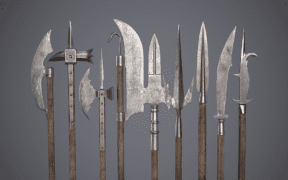Exploring the Various Types of Chinese Dao Saber
NO AI USED This Article has been written and edited by our team with no help of the AI

The Chinese saber, the dao, reflects China’s military heritage and martial arts tradition. Throughout history, the dao has evolved into various designs, some by the military for specific wartime needs and others by martial artists for certain skills.
In this article, we explore the different types of Chinese dao sabers, how they are categorized by length and blade shape, and the terminologies used in Chinese military texts or collectors.
What Exactly Is a Dao?
The term dao, 刀 encompasses a diverse range of Chinese single-edged weapons. While most associate it with the curved-blade saber, it can also refer to other types, including backswords, falchions, polearms, and knives. When it comes to the Chinese saber, its single-edged blade comes in a variety of shapes.
In his journal discussing the sabers of the Qing dynasty, Philip M. W. Tom states, “Dao may be straight, long and curved, short and compact, or broad with angular points.”
Peter Dekker, an expert in antique arms and armor, noted that it is preferable to use specific terms such as peidao (waist-worn saber) or niuweidao (oxtail saber) when describing the standard Chinese saber.
Different Types of Chinese Dao Saber
The Chinese saber has several forms, each with its distinct name. Generally, dao are categorized by length: short sabers (duan dao) and long sabers (changdao). Some were traditionally used in Chinese martial arts while others were worn by military officials during the Ming and Qing dynasties.
Duan Dao (Short Saber)
A duan dao, 短刀 (short saber) typically measures less than 39 inches (100 centimeters) in overall length. While it is generally wielded with one hand, both hands can be used when necessary.
1. Peidao or Yaodao (Waist-Worn Saber)
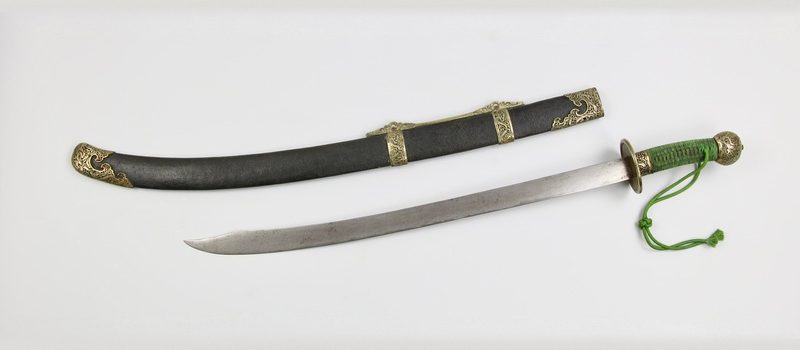
Both the terms peidao, 佩刀 and yaodao, 腰刀 refer to sabers worn at the waist, describing how they are carried. It encompasses any dao worn suspended from the hip, with the scabbard attached to a belt by cords.
Qing dynasty regulations in the Huangchao Liqi Tushi specify peidao patterns used during military reviews and parades. For example, the emperor, princes, and imperial guardsmen were permitted precious stones in peidao mountings while soldiers generally used plain brass.
- Design: Typically curved or straight, single-edged blades intended for one-handed use.
2. Dadao (Great Saber)
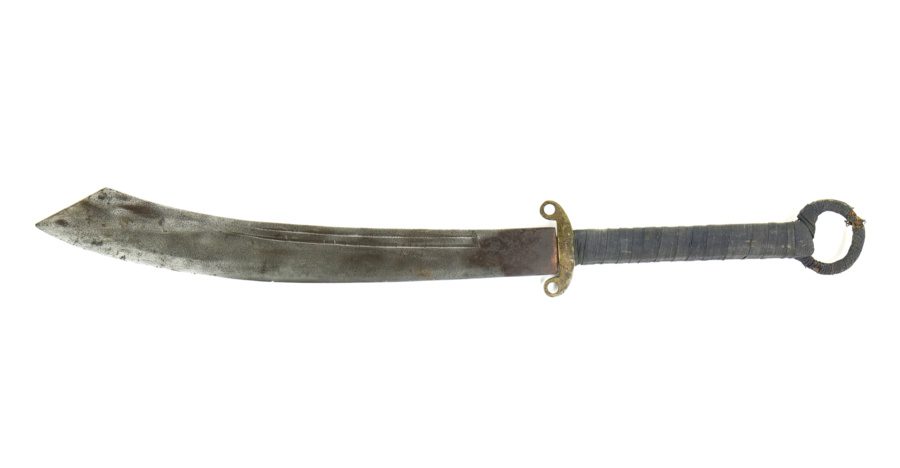
Designed for chopping, the dadao, 大刀 (big knife or great saber) is also known as kandao, 砍刀 (chopping or cleaving saber). It was typically carried across the bearer’s back rather than at the waist.
Today, it is mostly associated with post-Imperial China’s broad saber, used by soldiers during the Warlord Period, at the Marco Polo incident, and throughout World War II. It was highly effective in close combat, particularly in modern times when soldiers wore minimal protection.
- Design: Wide, flat blade with maximum width located just behind the cutting edge
3. Hudiedao (Butterfly Swords)
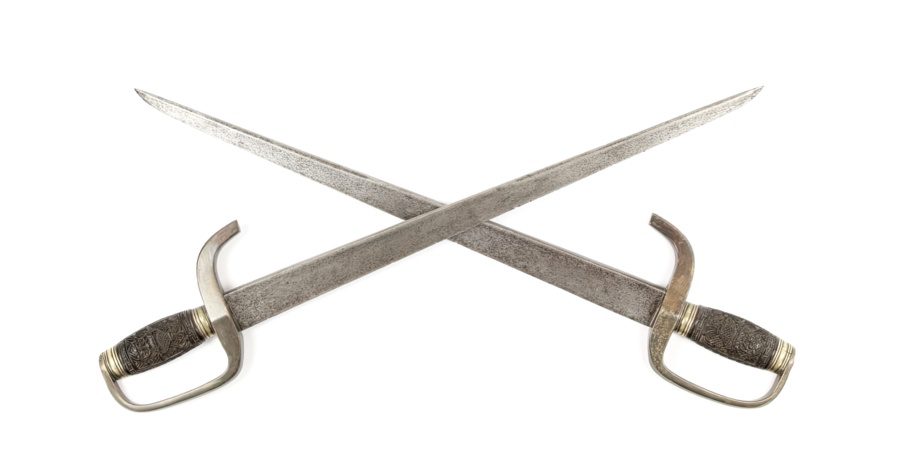
The hudiedao, 蝴蝶刀 (butterfly swords) is a type of double sword that originated in southern China. Also called bat jam do, 八斬刀 (eight cutting knives) in Cantonese, it comes in various blade shapes. Wider blades are mostly associated with southern Chinese martial arts, such as Wing Chun, Choi Li Fut, and Hung Gar.
- Design: D-shaped guard and half-hilts for swords to fit side-by-side in a single scabbard and drawn as a single weapon.
- Variations: Military style—narrow blades that start wide and thick before tapering to sharp tips. Others include curved blades with raised back edges and designs influenced by the blade styles of southern ethnic minorities.
Changdao (Long Saber)
Changdao, 長刀 (long knife) refers to a category of two-handed sabers, typically measuring between 47.2 to 70.9 inches (120 to 180 centimeters) in overall length with its hilts always shorter than the blades.
1. Miaodao (Sprout Saber)

Miaodao, 苗刀 (sprout saber) originally described a narrow, slightly curved blade on short and long sabers.
Today, it refers to the large two-handed saber used in Chinese martial arts, its design influenced by the Japanese odachi used by wokou (Japanese pirates) who raided the Chinese coasts. Its use is documented in the swordsmanship manual 單刀法選 (Dan Dao Fa Xuan), written during the Ming dynasty.
- Old names: Changdao (long saber), wodao (Japanese-style saber), shuangshou dao (double-handed saber), or dandao (single saber)
2. Long Sabers of the Green Standard Army
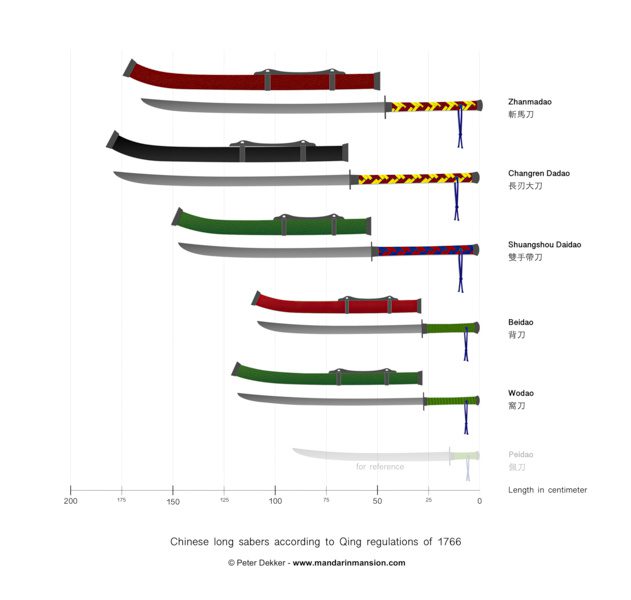
During the height of the Qing dynasty, various long sabers employed by the Green Standard Army include the zhanmadao (horse cutter), changren dadao (long-edged great saber), shuangshou dadao (double-handed saber), beidao (back saber), and wodao (bandit lair saber).
Consisting of Han dynasty soldiers and commanded by Green Standard officers and Eight Banners staff, they played a crucial role in the numerous conquests of early and high Qing periods as the largest military force of the Qing.
Types of Peidao: Waist-Worn Sabers Classified by Blade Shape
Peidao (waist-worn saber) is a type of Chinese saber that can be further categorized by blade shape. The terminology is derived from military texts, classic literature, and jargon used by collectors and martial artists.
1. Zhibeidao (Straight Back Saber)

The zhibeidao, 直背刀 or zhidao, 直刀 (straight dao) was the standard military sidearm until curved sabers were introduced to China by Mongols.
- Design: Straight, single-edged blade, with its edge parallel to the back
2. Yanmaodao (Goose Quill Saber)

Yanmaodao, 雁毛刀 (goose-quill saber) or yanlingdao, 雁翎刀 (goose-feather saber) in classical literature has a design that represents the transitional phase between the zhibeidao and fully curved sabers. It likely originated during the Ming dynasty and remained in use until the Qing dynasty.
- Design: Predominantly straight blade along its length before sweeping upward
- Variation: Some have a raised back edge, a characteristic often seen in Turkish sabers called yelman.
3. Liuyedao (Willow Leaf Saber)

Liuyedao, 柳葉刀 (willow leaf saber) was the most popular Chinese saber during the Ming and Qing dynasties. With slightly to deeply curved blades that are narrow or wide, the willow leaf-shaped blade is believed to have been introduced from Mongol conquests.
4. Yanchidao (Goose Wing Saber)

A subtype of the liuyedao—the yanchidao, 雁翅刀 (goose wing saber) has a clipped tip that can be straight, concave, hollow, serrated, or scalloped. This distinguishing feature first appeared during the Song dynasty but became increasingly rare by the Qing dynasty.
Some scalloped designs resemble the feather tips on a bird’s wing, giving rise to its name. The yanchidao is also referred to as fengchidao (風翅刀), meaning phoenix wing saber.
5. Yutoudao (Fish Head Saber)

Yutoudao, 魚頭刀 (fish head saber) likely originated from the late Ming dynasty. Its defining feature is the peaked spine near the tip, and some examples even have engraved eyes and gills to highlight their fish-like appearance.
6. Piandao (Slicing Saber)

Piandao, 㓲刀 (slicing saber) is one of the rarest in Chinese weaponry, and was mainly used by specialized shield-bearing units during the Ming and Qing dynasties. It has a deep curvature that runs along the entire blade, making it ideal for draw cuts in close quarters.
7. Niuweidao (Oxtail Saber)

Niuweidao, 牛尾刀 (oxtail saber) has a broad blade, which gradually widens before ending in a leaf-shaped tip. This design is optimized for cutting through softer, unarmored targets. It was developed in civilian circles and gained popularity among martial artists and rebels during the unrest that led to the fall of the Qing dynasty.
8. Woyaodao (Japanese-Style Waist-Worn Saber)

The woyaodao, 倭腰刀 (Japanese-style waist-worn saber) features a narrow, curved, ridged blade that resembles the shinogi ridge line found on Japanese blades.
Peter Dekker, an expert in antique arms and armor, coined the term woyaodao, merging the terms wodao (two-handed saber of Japanese-inspired design) and yaodao (Chinese saber intended to be worn at the waist).


